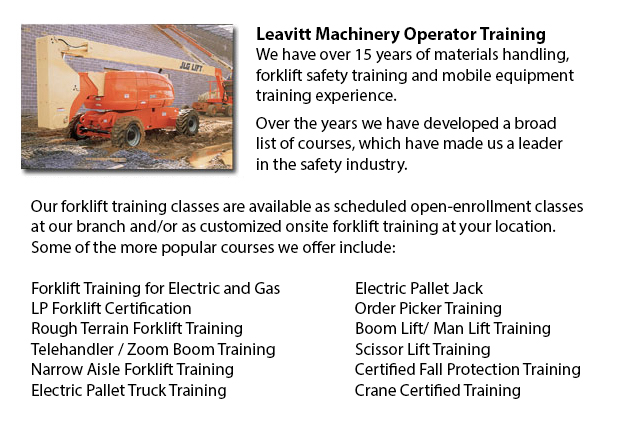
Aerial Platform Training Mississauga - Aerial forklifts are able to accommodate numerous odd jobs involving high and tricky reaching spaces. Normally utilized to execute daily maintenance in buildings with tall ceilings, trim tree branches, hoist heavy shelving units or repair phone lines. A ladder might also be utilized for some of the aforementioned projects, although aerial lifts offer more security and strength when properly used.
There are a variety of different versions of aerial hoists available, each being capable of performing slightly different tasks. Painters will sometimes use a scissor lift platform, which can be utilized to reach the 2nd story of buildings. The scissor aerial jacks use criss-cross braces to stretch out and extend upwards. There is a table attached to the top of the braces that rises simultaneously as the criss-cross braces lift.
Cherry pickers and bucket trucks are a different kind of the aerial lift. Usually, they contain a bucket at the end of a long arm and as the arm unfolds, the attached bucket lift rises. Forklifts utilize a pronged arm that rises upwards as the lever is moved. Boom hoists have a hydraulic arm which extends outward and elevates the platform. Every one of these aerial lifts require special training to operate.
Training programs offered through Occupational Safety & Health Association, acknowledged also as OSHA, deal with safety methods, system operation, repair and inspection and machine load capacities. Successful completion of these education courses earns a special certified license. Only properly licensed individuals who have OSHA operating licenses should run aerial lift trucks. The Occupational Safety & Health Organization has formed guidelines to maintain safety and prevent injury while utilizing aerial lift trucks. Common sense rules such as not using this machine to give rides and making sure all tires on aerial platform lifts are braced so as to hinder machine tipping are mentioned within the rules.
Sadly, data expose that greater than 20 aerial hoist operators die each year while operating and nearly ten percent of those are commercial painters. The majority of these incidents were triggered by improper tie bracing, for that reason several of these might have been prevented. Operators should make sure that all wheels are locked and braces as a critical safety precaution to stop the device from toppling over.
Marking the neighbouring area with observable markers have to be utilized to safeguard would-be passers-by so they do not come near the lift. Also, markings must be set at about 10 feet of clearance between any power lines and the aerial hoist. Lift operators must at all times be properly harnessed to the hoist while up in the air.
-
Forklift Certification Courses Mississauga
Forklift Certification Courses Mississauga - Forklift certification courses really help to be able to make certain that businesses operating forklifts, follow the local and regional rules. The operators of the forklift must go through forklift certif... More -
Heavy Equipment Certification Mississauga
Heavy Equipment Certification Mississauga - Big pieces of machinery and heavy-duty vehicles are often referred to as heavy equipment. This broad term covers utility vehicles from agricultural and forestry implements to construction equipment, civil e... More -
Skid Steer Loader Training in Mississauga
The engine powered skid-steer loader has a rigid and small frame, outfitted together with lift arms that can attach to lots of industrial attachments and tools to perform numerous labor saving tasks. Usually, skid-steer loaders are four-wheel drive v... More -
Bucket Truck Training Mississauga
Bucket Truck Training Mississauga - The Vehicle-Mounted Aerial Work Platform or bucket truck training program is designed to decrease the possibility of incident and personal injury when working with or in close proximity to bucket trucks by efficien... More -
Scissor Lift Certification Mississauga
Scissor Lift Certification Mississauga - Scissor lift platforms are used at work locations to enable tradespeople - like for example welders, masons and iron workers - to reach their work. Utilizing a scissor lift platform is typically secondary to t... More -
Order Picker License Mississauga
Order Picker License Mississauga - Order preparation operation or order picking as it is more normally known is a process used within warehouse operations and comprises personnel called order pickers. The order picker's job is to take and collect art... More -
Forklift Train The Trainer Mississauga
Forklift Train The Trainer Mississauga - Our company provides the most advanced and latest Forklift Training courses in North America. We provide industrial workplace safety training, Train the Trainer, mobile equipment operator, and self study train... More -
Manlift Operator Training Mississauga
Manlift Operator Training Mississauga - The aerial lift or manlift is a specialized kind of hydraulic platform which is meant to hoist a person vertically giving it an alternate name of a vertical personnel lift. These machinery are widely utilized f... More

Forklift Training Mississauga
TOLL FREE: 1-888-254-6157
Mississauga, Ontario
forklifttrainingmississauga.ca
Email Us
About Us


